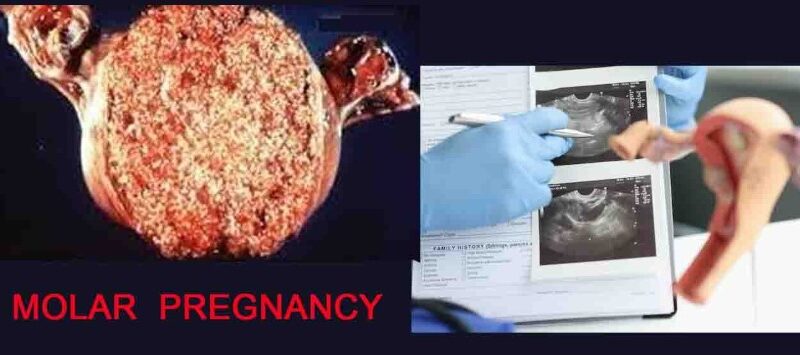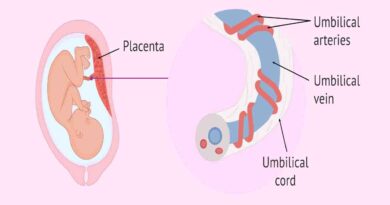Molar Pregnancy: Types, Symptoms, Causes & Treatments
Molar Pregnancy: Types, Symptoms, Causes & Treatments, also known as a hydatidiform mole, is a rare abnormality that occurs during early pregnancy. It is characterized by the development of abnormal tissue instead of a normal embryo. This condition can lead to various complications and must be diagnosed and treated promptly. In this article, we will explore the different types of molar pregnancy, its symptoms, causes, and the available treatments.
Types of Molars Pregnancy
There are two main types of molar pregnancy: –
- complete molar pregnancy
- partial molar pregnancy.
Complete Molar Pregnancy
Molar Pregnancy, also known as a hydatidiform mole, is a rare and abnormal condition that occurs during early pregnancy. In a complete molar pregnancy, the fertilization of the egg by the sperm results in the absence of fetal tissue, but instead, there is an overgrowth of abnormal placental tissue. This condition leads to the formation of a cluster of fluid-filled sacs, resembling a grape-like mass, within the uterus. A complete molar pregnancy cannot develop into a viable fetus and poses significant health risks to the mother. It requires immediate medical attention and typically results in the removal of the abnormal tissue through a surgical procedure.
Partial Molar Pregnancy
Molar Pregnancy is a rare type of abnormal pregnancy that occurs when two sperm fertilize one egg, resulting in an embryo with an extra set of chromosomes (69 instead of the usual 46). This leads to the development of abnormal placental tissue and a nonviable fetus. The pregnancy is characterized by severe complications, such as rapid growth of the uterus, higher levels of pregnancy hormones, and a risk of gestational trophoblastic disease. Treatment typically involves dilation and curettage to remove the abnormal tissue. Close monitoring and follow-up are essential to ensure the complete resolution of the condition.
Symptoms of Molar Pregnancy
The symptoms of molar pregnancy can vary from woman to woman, and they may mimic those of a normal pregnancy. However, some specific signs indicate the possibility of a molar pregnancy.
Vaginal Bleeding
The bleeding may range from light spotting to heavy hemorrhaging. It is a common and concerning sign of this abnormal pregnancy. Other symptoms may include severe nausea and vomiting, rapid uterine growth, and early signs of preeclampsia, such as high blood pressure and protein in the urine. A molar pregnancy occurs when a nonviable fertilized egg implants in the uterus and develops into an abnormal mass of tissue, known as a hydatidiform mole, instead of a healthy fetus. Vaginal bleeding in early pregnancy should always be promptly evaluated by a healthcare provider.
Severe Nausea and Vomiting

Occur when there are problems with the fertilization of the egg, leading to the formation of abnormal tissue inside the uterus instead of a developing fetus. This abnormal tissue, known as a “mole,” can cause hormonal imbalances that result in intense nausea and vomiting. Additionally, molar pregnancies may also present with other symptoms, such as vaginal bleeding, abdominal pain or cramping, and rapid enlargement of the uterus. If a molar pregnancy is suspected, immediate medical attention is necessary to manage the condition and prevent potential complications.
Rapid Uterine Enlargement
The most prominent and concerning symptom is rapid uterine enlargement. This occurs due to the abnormal growth of placental tissue within the uterus. The developing placenta in a molar pregnancy tends to grow faster than a normal pregnancy, leading to an unusually large uterus for the gestational age. This rapid uterine enlargement can cause discomfort and pain for the woman. Other possible symptoms of a molar pregnancy may include vaginal bleeding (often bright red or brownish in color), severe nausea and vomiting (hyperemesis gravidarum), and elevated levels of the pregnancy hormone hCG (human chorionic gonadotropin) in the blood. If any of these symptoms are experienced, immediate medical attention is necessary to diagnose and manage the condition.
Absent Fetal Heartbeat
Absent fetal heartbeat is a rare complication of pregnancy characterized by abnormal growth of placental tissue. In the case of a complete molar pregnancy, there is no fetus or viable embryo present. Common symptoms include vaginal bleeding, severe nausea and vomiting, excessive uterine enlargement, and rapid growth of the uterus. In a molar pregnancy, the absence of a fetal heartbeat is a clear indication that a normal pregnancy has not developed. If you experience any of these symptoms, it’s essential to seek immediate medical attention to diagnose and manage the condition, as molar pregnancies can be associated with potential complications.
High Blood Pressure and Preeclampsia
Molar pregnancy, also known as a hydatidiform mole, is a rare complication of pregnancy that can lead to high blood pressure and preeclampsia. Symptoms of molar pregnancy may include vaginal bleeding, severe nausea and vomiting, rapid uterine growth, and absence of fetal heart sounds. As the condition progresses, it can cause gestational hypertension, characterized by high blood pressure during pregnancy. In some cases, molar pregnancy can progress to preeclampsia, a serious condition that can lead to organ damage and affect the placenta’s function. Prompt medical attention is crucial to manage and treat these conditions effectively.
Causes of Molar Pregnancy
The exact causes of molar pregnancy are not fully understood, but they are believed to be related to errors in the fertilization process.
Abnormal Fertilization
Molar Pregnancy, also known as a hydatidiform mole, is a rare type of abnormal pregnancy that occurs due to abnormal fertilization of the egg. In a molar pregnancy, the fertilization process leads to the development of abnormal tissue within the uterus instead of a normal fetus.
There are two main types of molar pregnancies:
- Complete Molar Pregnancy: This occurs when a sperm fertilizes an egg that contains no genetic material from the mother. The resulting embryo is non-viable and does not develop into a fetus.
- Partial Molar Pregnancy: This happens when a normal egg is fertilized by two sperm, resulting in an extra set of chromosomes. This abnormal genetic makeup prevents normal fetal development.
Both types of molar pregnancies require medical attention and monitoring due to their potential complications.
Age and Previous History
Molar pregnancy, also known as gestational trophoblastic disease, is a rare and abnormal type of pregnancy that occurs when there is a problem with the fertilization of an egg. Two main causes of molar pregnancy are:
- Age: Women who are younger than 20 or older than 35 have a higher risk of molar pregnancy.
- Previous History: Women who have had a molar pregnancy in the past are at an increased risk of experiencing it again in subsequent pregnancies.
It’s essential for women with these risk factors to undergo regular prenatal checkups to detect any signs of molar pregnancy early and receive appropriate medical care.
Nutritional Deficiencies

nutritional deficiencies also known as a hydatidiform mole, is a rare abnormality that occurs during early pregnancy. It is not caused by nutritional deficiencies. Instead, it is a result of an abnormal fertilization of the egg, leading to the growth of abnormal placental tissue instead of a healthy embryo. Molar pregnancies are not caused by factors related to the mother’s diet or nutritional status. These pregnancies are usually detected during routine ultrasound scans and can lead to complications if not managed appropriately, requiring medical intervention such as a dilation and curettage procedure to remove the abnormal tissue.
Treatments for Molar Pregnancy
Once diagnosed, molar pregnancies require prompt medical intervention to prevent complications and ensure the well-being of the mother.
Evacuation of the Uterus (Dilation and Curettage)
The primary treatment for molar pregnancy is the evacuation of the uterus through a procedure called dilation and curettage (D&C). During this procedure, the cervix is dilated, and the abnormal placental tissue is removed from the uterus using a curette or suction device. D&C is typically performed under general or local anesthesia. After the procedure, the removed tissue is sent for pathological examination to confirm the diagnosis and ensure the complete removal of the molar tissue. Regular follow-up visits and monitoring of the human chorionic gonadotropin (hCG) hormone levels are essential to detect any potential complications or recurrences.
Monitoring and Follow-Up
Treatment for molar pregnancy involves removing the abnormal tissue from the uterus through a procedure called dilation and curettage (D&C). After the procedure, careful monitoring and follow-up are essential to ensure complete removal of the molar tissue and to detect any potential complications. Regular blood tests to monitor hCG (human chorionic gonadotropin) levels are performed until hCG levels return to normal. Following the successful resolution of a molar pregnancy, women are advised to avoid pregnancy for at least six months to a year. Close medical supervision during this time is crucial to prevent any recurrence or complications.
Hysterectomy
The primary treatment for molar pregnancy is a hysterectomy, which involves the surgical removal of the uterus. This procedure is usually recommended when there is a complete molar pregnancy (no fetus forms) or when a partial molar pregnancy has complications. A hysterectomy helps remove the abnormal tissue and prevents further complications such as persistent trophoblastic disease or the development of gestational trophoblastic neoplasia (cancerous growth). In cases where the molar pregnancy is detected early and there are no complications, other treatments like dilation and curettage (D&C) or chemotherapy may be considered as alternatives to a hysterectomy.
Emotional Support

Emotional support is crucial for women experiencing a molar pregnancy, which can be emotionally challenging. Here are some treatment approaches to provide emotional support:
- Counseling or Therapy: Individual or group therapy sessions can offer a safe space to express feelings, fears, and concerns related to the molar pregnancy.
- Support Groups: Joining support groups with other women who have experienced molar pregnancies can provide a sense of belonging and understanding.
- Partner and Family Involvement: Involving partners and family members in the process can help create a strong support network.
- Open Communication: Encouraging open communication with healthcare providers and loved ones can foster a supportive environment.
- Self-Care: Practicing self-care activities, such as meditation, relaxation techniques, and engaging in hobbies, can aid emotional healing.
Molar pregnancy is a rare and potentially serious condition that requires early diagnosis and appropriate treatment. Complete and partial molar pregnancies have distinct characteristics and symptoms. Prompt evacuation of the uterus through dilation and curettage is the standard treatment, followed by monitoring of hCG levels. With proper medical care and emotional support, most women can recover from a molar pregnancy and go on to have a healthy pregnancy in the future. It is crucial for women to attend regular prenatal checkups to ensure early detection and intervention in case of any complications during pregnancy.
See this also.




